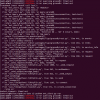Due to the violin mode problem on 10/25, Sheila has asked me to investigate when this mode really started to rung up. The first plot attached shows that the amplitude of 1008.45Hz were consistant the day before the power glitch and three hours before power glitch (the small difference you see is within the mode normal fluctuation range). The second plot shows the 1008.45 Hz got rung up by an order of magnitude during the first lock acquired after the power glitch just like others. Because this mode didn't have a damping filter at the time, ideally the amplitude should have stayed where it was. However, the final plot shows that the amplitude became worse as time progress while other modes were either stable or being damped until it caused the problem on October 25th. Could anything that happened during the power lost caused the mode to change its phase as it seems to be slowly rung up by ETMY MODE3 that's been existing since before O1? Note that this violin mode had never rung up before. The investigation continues.
To ensure that the 1008.45Hz line hasn't been slowly ringing up all this time, I've looked back at the asd amplitude of this mode until October 1st. First plot attached shows the amplitude/sqrt(Hz) versus frequency of this particular mode, one plot per day. The second plot shows log amplitude versus time. I only plotted one data point per day (10:00:00 UTC if data available, or any time where the BNS range was stable and the ifo was locked for at least an hour). The last data point is today (10/28 02:00:00 UTC). This mode has been fluctuating between 1e-22 and 1e-21 since the begining of the month (10/01) up until 10/20. You can see clearly that the amplitude begins to rise above its nominal on 10/21 after the power outage on 10/20 and continues to grow exponentially until it started to cause problems on 10/25. Indicates that the amplitude grow was causing by a positive feedback, which Sheila found it to be ETMY MODE3.
To conclude this study: This mode wasn't, and hasn't been ringing up before October 20th. Why it started to ring up after power outage is unclear. I can't think of anything else but something must have changed to cause this mode to change phase during the power outage.
Should we worry...?
Was there a significant temperature excursion during the power outage?
Yes.
I've attached the plot of average temperature in the VEAs. After the power outage LVEA average temperature had three big dips of about half degree. Average temperature at EY seems to fluxtuate more often and EX had couple of large drops.
Which turns out to be just a coincidence with the power outage according to John.















